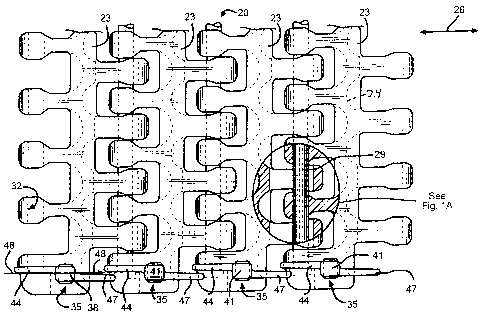Une partie des informations de ce site Web a été fournie par des sources externes. Le gouvernement du Canada n'assume aucune responsabilité concernant la précision, l'actualité ou la fiabilité des informations fournies par les sources externes. Les utilisateurs qui désirent employer cette information devraient consulter directement la source des informations. Le contenu fourni par les sources externes n'est pas assujetti aux exigences sur les langues officielles, la protection des renseignements personnels et l'accessibilité.
L'apparition de différences dans le texte et l'image des Revendications et de l'Abrégé dépend du moment auquel le document est publié. Les textes des Revendications et de l'Abrégé sont affichés :
| (12) Brevet: | (11) CA 2380127 |
|---|---|
| (54) Titre français: | PROTECTEURS LATERAUX ENCLIQUETABLES |
| (54) Titre anglais: | SNAP-ON SIDE GUARDS |
| Statut: | Périmé et au-delà du délai pour l’annulation |
| (51) Classification internationale des brevets (CIB): |
|
|---|---|
| (72) Inventeurs : |
|
| (73) Titulaires : |
|
| (71) Demandeurs : |
|
| (74) Agent: | SMART & BIGGAR LP |
| (74) Co-agent: | |
| (45) Délivré: | 2005-10-25 |
| (22) Date de dépôt: | 2002-04-04 |
| (41) Mise à la disponibilité du public: | 2003-01-19 |
| Requête d'examen: | 2002-04-04 |
| Licence disponible: | S.O. |
| Cédé au domaine public: | S.O. |
| (25) Langue des documents déposés: | Anglais |
| Traité de coopération en matière de brevets (PCT): | Non |
|---|
| (30) Données de priorité de la demande: | ||||||
|---|---|---|---|---|---|---|
|
An endless conveyor belt formed of plastic belt
modules and capable of following a curved path. The
modules include first and second module surfaces, i.e.,
a top, product-conveying surface and a bottom, sprocket-
driven surface. An intermediate section extends across
the width of each module transverse to the direction of
belt travel.
A plurality of snap-on side guards are mounted in
vertical openings disposed in the belt modules. Each
side guard includes a central post having opposed wings
extending in a forwardly and a rearwardly direction
along the direction of conveyor belt travel. The wings
are staggered in the lateral direction so that the
forward wing of a first side guard overlaps with the
rearward wing of an immediately adjacent second side
guard.
Note : Les revendications sont présentées dans la langue officielle dans laquelle elles ont été soumises.
Note : Les descriptions sont présentées dans la langue officielle dans laquelle elles ont été soumises.

2024-08-01 : Dans le cadre de la transition vers les Brevets de nouvelle génération (BNG), la base de données sur les brevets canadiens (BDBC) contient désormais un Historique d'événement plus détaillé, qui reproduit le Journal des événements de notre nouvelle solution interne.
Veuillez noter que les événements débutant par « Inactive : » se réfèrent à des événements qui ne sont plus utilisés dans notre nouvelle solution interne.
Pour une meilleure compréhension de l'état de la demande ou brevet qui figure sur cette page, la rubrique Mise en garde , et les descriptions de Brevet , Historique d'événement , Taxes périodiques et Historique des paiements devraient être consultées.
| Description | Date |
|---|---|
| Le délai pour l'annulation est expiré | 2009-04-06 |
| Lettre envoyée | 2008-04-04 |
| Inactive : CIB de MCD | 2006-03-12 |
| Accordé par délivrance | 2005-10-25 |
| Inactive : Page couverture publiée | 2005-10-24 |
| Inactive : Taxe finale reçue | 2005-08-16 |
| Préoctroi | 2005-08-16 |
| Un avis d'acceptation est envoyé | 2005-03-31 |
| Lettre envoyée | 2005-03-31 |
| Un avis d'acceptation est envoyé | 2005-03-31 |
| Inactive : Approuvée aux fins d'acceptation (AFA) | 2005-03-21 |
| Modification reçue - modification volontaire | 2004-09-23 |
| Inactive : Dem. de l'examinateur par.30(2) Règles | 2004-03-23 |
| Inactive : Page couverture publiée | 2003-01-19 |
| Demande publiée (accessible au public) | 2003-01-19 |
| Modification reçue - modification volontaire | 2002-11-15 |
| Inactive : CIB en 1re position | 2002-06-21 |
| Inactive : CIB attribuée | 2002-06-21 |
| Inactive : Certificat de dépôt - RE (Anglais) | 2002-05-08 |
| Exigences de dépôt - jugé conforme | 2002-05-08 |
| Lettre envoyée | 2002-05-08 |
| Lettre envoyée | 2002-05-08 |
| Demande reçue - nationale ordinaire | 2002-05-08 |
| Exigences pour une requête d'examen - jugée conforme | 2002-04-04 |
| Toutes les exigences pour l'examen - jugée conforme | 2002-04-04 |
Il n'y a pas d'historique d'abandonnement
Le dernier paiement a été reçu le 2005-01-28
Avis : Si le paiement en totalité n'a pas été reçu au plus tard à la date indiquée, une taxe supplémentaire peut être imposée, soit une des taxes suivantes :
Veuillez vous référer à la page web des taxes sur les brevets de l'OPIC pour voir tous les montants actuels des taxes.
| Type de taxes | Anniversaire | Échéance | Date payée |
|---|---|---|---|
| Taxe pour le dépôt - générale | 2002-04-04 | ||
| Enregistrement d'un document | 2002-04-04 | ||
| Requête d'examen - générale | 2002-04-04 | ||
| TM (demande, 2e anniv.) - générale | 02 | 2004-04-05 | 2004-02-13 |
| TM (demande, 3e anniv.) - générale | 03 | 2005-04-04 | 2005-01-28 |
| Taxe finale - générale | 2005-08-16 | ||
| TM (brevet, 4e anniv.) - générale | 2006-04-04 | 2006-01-23 | |
| TM (brevet, 5e anniv.) - générale | 2007-04-04 | 2007-01-24 |
Les titulaires actuels et antérieures au dossier sont affichés en ordre alphabétique.
| Titulaires actuels au dossier |
|---|
| HABASIT AG |
| Titulaires antérieures au dossier |
|---|
| DIETER GULDENFELS |
| ENRICO VISCONTI |